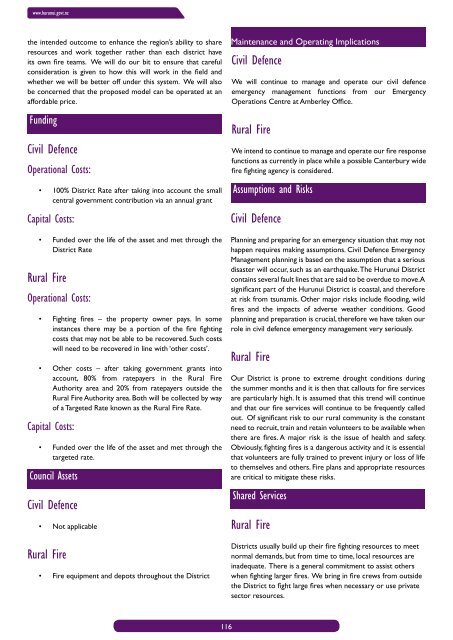Draft Long Term Plan 2012-2022 - Hurunui District Council
Draft Long Term Plan 2012-2022 - Hurunui District Council
Draft Long Term Plan 2012-2022 - Hurunui District Council
Create successful ePaper yourself
Turn your PDF publications into a flip-book with our unique Google optimized e-Paper software.
www.hurunui.govt.nzthe intended outcome to enhance the region’s ability to shareresources and work together rather than each district haveits own fire teams. We will do our bit to ensure that carefulconsideration is given to how this will work in the field andwhether we will be better off under this system. We will alsobe concerned that the proposed model can be operated at anaffordable price.FundingCivil DefenceOperational Costs:• 100% <strong>District</strong> Rate after taking into account the smallcentral government contribution via an annual grantCapital Costs:• Funded over the life of the asset and met through the<strong>District</strong> RateRural FireOperational Costs:• Fighting fires – the property owner pays. In someinstances there may be a portion of the fire fightingcosts that may not be able to be recovered. Such costswill need to be recovered in line with ‘other costs’.• Other costs – after taking government grants intoaccount, 80% from ratepayers in the Rural FireAuthority area and 20% from ratepayers outside theRural Fire Authority area. Both will be collected by wayof a Targeted Rate known as the Rural Fire Rate.Capital Costs:• Funded over the life of the asset and met through thetargeted rate.<strong>Council</strong> AssetsCivil Defence• Not applicableRural Fire• Fire equipment and depots throughout the <strong>District</strong>Maintenance and Operating ImplicationsCivil DefenceWe will continue to manage and operate our civil defenceemergency management functions from our EmergencyOperations Centre at Amberley Office.Rural FireWe intend to continue to manage and operate our fire responsefunctions as currently in place while a possible Canterbury widefire fighting agency is considered.Assumptions and RisksCivil Defence<strong>Plan</strong>ning and preparing for an emergency situation that may nothappen requires making assumptions. Civil Defence EmergencyManagement planning is based on the assumption that a seriousdisaster will occur, such as an earthquake. The <strong>Hurunui</strong> <strong>District</strong>contains several fault lines that are said to be overdue to move. Asignificant part of the <strong>Hurunui</strong> <strong>District</strong> is coastal, and thereforeat risk from tsunamis. Other major risks include flooding, wildfires and the impacts of adverse weather conditions. Goodplanning and preparation is crucial, therefore we have taken ourrole in civil defence emergency management very seriously.Rural FireOur <strong>District</strong> is prone to extreme drought conditions duringthe summer months and it is then that callouts for fire servicesare particularly high. It is assumed that this trend will continueand that our fire services will continue to be frequently calledout. Of significant risk to our rural community is the constantneed to recruit, train and retain volunteers to be available whenthere are fires. A major risk is the issue of health and safety.Obviously, fighting fires is a dangerous activity and it is essentialthat volunteers are fully trained to prevent injury or loss of lifeto themselves and others. Fire plans and appropriate resourcesare critical to mitigate these risks.Shared ServicesRural Fire<strong>District</strong>s usually build up their fire fighting resources to meetnormal demands, but from time to time, local resources areinadequate. There is a general commitment to assist otherswhen fighting larger fires. We bring in fire crews from outsidethe <strong>District</strong> to fight large fires when necessary or use privatesector resources.116
















